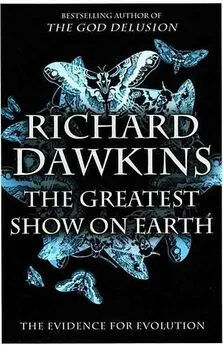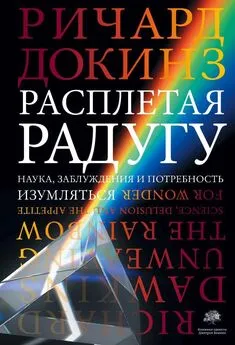Ричард Докинз - Рассказ предка. Путешествие к заре жизни.
- Название:Рассказ предка. Путешествие к заре жизни.
- Автор:
- Жанр:
- Издательство:неизвестно
- Год:неизвестен
- ISBN:нет данных
- Рейтинг:
- Избранное:Добавить в избранное
-
Отзывы:
-
Ваша оценка:
Ричард Докинз - Рассказ предка. Путешествие к заре жизни. краткое содержание
«Рассказ Предка» – это странствие длиной четыре миллиарда лет. Мы, современные люди, путешествуем назад во времени в поисках нашего предка. В то же время любое другое живое создание – животное, растение, гриб, бактерия – каждый совершает свое собственное путешествие. Вместе мы идем назад во времени, встречая другие группы странников, с которыми мы разделяем общего предка.
Мы продвигаемся, пренебрегая опасностью, через массовые вымирания, встречая все более и более отдаленных общих предков. В конечном счете, мы проходим тот фундаментальный поворотный момент для жизни на Земле, когда в одной клетке объединились будущее простейшее с бактерией, чтобы сформировать клетку с ядром. Как только мы достигли этого момента, все живые существа вместе совершают заключительное путешествие к возникновению жизни.
Этот величественный рассказ объединяет эту замечательную книгу. Все же, хроника путешествия представляет собой коллекцию отдельных рассказов, поведанных странниками. Эти рассказы охватывают процессы, связанные с разворачиванием жизни на Земле. Чрезвычайно богатые и разнообразные, они включают в себя результаты недавних открытий, основанных на исследовании ДНК, чтобы дать потрясающую возможность немного проникнуть в суть эволюционной истории. Фундаментальный принцип эволюционного развития лежит в основе каждого рассказа и связывает их в эту уникальную историю: нашу историю и историю всех живых существ.
Сутью этой книги является рассмотрение наших предков и наших связей с другими живыми существами. «Рассказ Предка» показывает нам, насколько мы замечательны, как удивительна наша история и как близки наши отношения с остальным живым миром.
Предлагаемый перевод этой книги был найден где-то на просторах Интернета. Насколько известно автору этого файла, эта книга никогда не издавалась на русском языке и предлагаемый здесь перевод является любительским со всеми сопутствующими этому обстоятельству огрехами. Однако это не умаляет труда автора перевода. Хотелось бы выразить ему глубочайшую признательность, так как не столь многое может считаться более достойным, чем бескорыстный труд во благо Просвещения.
Рассказ предка. Путешествие к заре жизни. - читать онлайн бесплатно ознакомительный отрывок
Интервал:
Закладка:
[21] BELL, G. (1982) The Masterpiece of Nature: The Evolution and Genetics of Sexuality. Croom Helm, London.
[22] BELLOC, H. (1999) Complete Verse. Random House Children's Books, London.
[23] BETZIG, L, (1995) Medieval monogamy.Journal of Family History 20:181-216.
[24] BLACKMORE, S. (1999) The M?me Machine. Oxford University Press, Oxford.
[25] BLAIR, W. F. (1955) Mating call and stage of speciation in the Microhyla olivacea – M. carolinensis complex. Evolution 9: 469-480.
[26] BLOCK. J. I. & BOYER, D. M. (2002) Grasping primate origins. Science 298: 1606-1610.
[27] BONNER. J. T. (1993) Life Cycles: Reflections of an Evolutionary Biologist. Princeton University Press, Princeton.
[28] BOURLAT. S. J., NIELSEN, C, LOCKYER, A. E., et al. (2003) Xenoturbellu is a deuterostome that eats molluscs. Nature 424: 925-928.
[29] BRASIER, M. D., GREEN, 0. R., JEPHCOAT. A. P., et al. (2002) Questioning the evidence for earth's oldest fossils. Nature 416: 76-81.
[30] BRIGGS, D., ERWIN. D. B., COLLIER, F. (1994) The Fossils of the Burgess Shale. Smithsonian Institution Press, Washington DC.
[31] BRIGGS, D. E. G. St FORTEY, R. A. (in press) Wonderful strife-systematics, stem groups and the phylogenetic signal of the Cambrian radiation. Paieobiology.
[32] BROMHAM, L. & DEGNAN, B. M. (1999) Hemichordates and deuterostome evolution: Robust molecular phylogenetic support for a hemichordate + echinoderm clade. Evolution and Development 1:166-171.
[33] BROMHAM, L. SI PENNY, D. (2003) The modern molecular clock. Nature Reviews Genetics 4: 216-224.
[34] BROMHAM. L., WOOLFIT, M., LEE, M. S. Y., & RAMBAUT. A. (2002) Testing the relationship between morphological and molecular rates of change along phylogenies. Evolution 56: 1921-1930.
[35] BROOKE, N. M. & HOLLAND, P. W. H. (2003) The evolution of multicellularity and early animal genomes. Current Opinion in Genetics & Development 13: 599-603.
[36] BRUNET, M., GUY, F., PILBEAM, D., etal. (2002) A new hominid from the Upper Miocene of Chad, central Africa. Nature 418: 145-151.
[37] BUCHSBAUM. R.(1987) Animals Without Backbones, University of Chicago Press, Chicago, 3rd edn.
[38] BUTTERFIELD. N.J. (2001) Paleobiology of the late Mesoproterozoic (ca. 1200 Ma) Hunting Formation, Somerset Island, arctic Canada. Precambrian Research 111: 235-256.
[39] CAIRNS-SMITH, A. G. (1985) Seven Clues to the Origin of Life. Cambridge University Press, Cambridge.
[40] CARROLL, R. L. (1988) Vertebrate Paleontology and Evolution. W.H. Freeman, New York.
[41] CATANIA, K. C. SI KAAS.J. H. (1997) Somatosensory fovea in the star-nosed mole: Behavioral use of the star in relation to innervation patterns and cortical representation.Journal of Comparative Neurology 387: 215-233.
[42] CAVALIER-SMITH, T. (2002) The neomuran origin of archaebacteria, the negibacterial root of the universal tree and bacterial megaclassification. International journal of Systematic and Evolutionary Microbiology 52: 7-76.
[43] CAVALIER-SMITH, T. 8, CHAO. E. E. Y. (2003) Phylogeny of Choanozoa, Apusozoa. and other Protozoa and early eukaryote megaevolution. Journal of Molecular Evolution 56: 540-563.
[44] CENSKY. E. J., HODGE, K., 8I DUDLEY, J. (1998) Overwater dispersal of lizards due to hurricanes. Nature 395: 556.
[45] CHANG. J. T. (1999) Recent common ancestors of all present-day individuals. Advances in Applied Probability 31:1002-1026.
[46] CHAUCER, G. (2000) Chaucer: The General Prologue on CD-ROM (Solopova, E., ed.). Cambridge University Press, Cambridge.
[47] CLACK, J. (2002) Gaining Ground: The Origin and Evolution of Tetrapods. Indiana University Press, Bloomington.
[48] CLARKE R. J. (1998) First ever discovery of a well-preserved skull and associated skeleton of Australopithecus. South African Journal of Science 94: 460-463.
[49] CLEVELAND, L. R. & GRIMSTONE. A. V. (1964) The fine structure of the flagellate Mixotricha paradoxa and its associated microorganisms. Proceedings of the Royal Society of London: Series B 159: 668-686.
[50] COLLINS. A. G. (2002) Phylogeny of medusozoa and the evolution of cnidarian lite cycles. Journal of Evolutionary Biology 15:418-432.
[51] CONWAY MORRIS, S. (1998) The Crucible of Creation: The Burgess Shale and the Rise of Animals. Oxford University Press, Oxford.
[52] CONWAY-MORRIS. S. (2003) Life's Solution: Inevitable Humans in a Lonely Universe. Cambridge University Press, Cambridge.
[53] COOPER, A. & FORTEY, R. (1998) Evolutionary explosions and the phylogenetic fuse. Trends in Ecology and Evolution 13:151-156.
[54] COPPENS. Y. (1994) East side story: The origin of humankind. Scientific American 111 (May): 88-95.
[55] COTT. H. B. (1940) Adaptive Coloration in Animals. Methuen. London.
[56] CRICK, F. H. C. (1981) Life Itself: Its Origin and Nature. Macdonald. London.
[57] CROCKFORD, S. (2002) Dog Evolution: A Role for Thyroid Hormone Physiology in Domestication Changes. Johns Hopkins University Press, Baltimore.
[58] CRONIN, H. (1991) The Ant and the Peacock: Altruism andSexuai Selection from Darwin to Today. Cambridge University Press, Cambridge.
[59] DARWIN, C. (1860/1859) On The Origin of Species by Means of Natural Selection. John Murray, London.
[60] DARWIN. C. (1987/1842) The Geology of the Voyage of HMS Beagle: The Structure and Distribution of Coral Reefs. New York University Press, New York.
[61] DARWIN, C. (2002/1839) The Voyage of the Beagle. Dover Publications, New York.
[62] DARWIN, C. (2003/1871) The Descent of Man. Gibson Square Books, London.
[63] DARWIN, F. (ed.) (1888) The Life And Letters of Charles Darwin. John Murray. London.
[64] DAUBIN, V., GOUY, M., Si PERRIERE, G. (2002) A phylogenomic approach to bacterial phylogeny: evidence for a core of genes snaring common history. Genome Research 12: 1080-1090.
[65] DAVIES, P. [199S) The Fifth Miracle: The Search for the Origin of Life. Allen Lane. The Penguin Press, London.
[66] DAWKINS, R. (1982) The Extended Phenotype. W. H. Freeman, Oxford.
[67] DAWKINS, R. (1986) The Blind Watchmaker. Longman, London.
[68] DAWKINS, R. (1989) The evolution of evolvability. In Artificial Life (Langton. C, ed.). pp. 201-220, Addison-Wesley. New York.
[69] DAWKINS, R. (1989) The Selfish Gene. Oxford University Press, Oxford, 2nd edn.
[70] DAWKINS, R. (1995) River Out of Eden. Weidenfeld & Nicolson. London.
[71] DAWKINS, R. (1996) Climbing Mount Improbable. Viking. London.
[72] DAWKINS, R. (1998) Unweaving the Rainbow. Penguin, London.
[73] DAWKINS. R. (2003) A Devil's Chaplain. Weidenfeld & Nicolson. London.
[74] DAWKINS, R. & KREBS.J. R. (1979) Arms races between and within species. Proceedings of the Royal Society of London: Series B 205:489-511.
[75] DE CARVALHO, M. R. (1996) Higher-level elasmobranch phylogeny, basal squaleans, and paraphyly. In Interrelationships of Fishes (Stiassny, M. L. J., Parenti, L. R., & Johnsson, G. D., eds.). pp. 35-62, Academic Press, San Diego.
[76] DE MORGAN, A. (2003/1866) A Budget of Paradoxes. The Thoemmes Library, Poole, Dorset.
[77] DE WAAL, F. (1995) Bonobo sex and society. Scientific American 272 (March): 82-88.
[78] DE WAAL, F. (1997) Bonobo: The Forgotten Ape. University of California Press, Berkeley.
[79] DENNETT. D. (1991) Consciousness Explained. Little Brown. Boston.
[80] DENNETT, D. (1995) Darwin's Dangerous Jdea: Evolution and the Meaning of Life. Simon & Schuster, New York.
[81] DEUTSCH, D. (1997) The Fabric of Reality. Allen Lane, The Penguin Press. London.
[82] DIAMOND, J. (1991) The Rise and Fall of the Third Chimpanzee. Radius. London.
[83] DIXON, D. (1981) After Man: A Zoology of the Future. Granada. London.
[84] DRAYTON. M. (1931-1941) The Works of Michael Drayton. Blackwell, Oxford.
[85] DUDLEY. J.W. & LAMBERT, R. J.(1992) Ninety generations of selection for oil and protein in maize. Maydica 37: 96-119.
[86] DULAI, K.S., VON DORNUM. M., MOLLON.J. D., & HUNT. D. M. (1999) The evolution of trichromatic color vision by opsin gene duplication in New World and Old World primates. Genome Research 9:629-638.
[87] DURHAM, W. H. (1991) Convolution: Genes, Culture and Human diversity. Stanford University Press. Stanford.
[88] DYSON, F. J. (1999) Origins of Life. Cambridge University Press, Cambridge. 2nd edn.
[89] EDWARDS, A. W. F. (2003) Human genetic diversity: Lewontin's fallacy. BioEssays 25: 798-801.
[90] EIGEN. M. (1992) Steps Towards Life: A Perspective on Evolution. Oxford University Press, Oxford.
[91] FENG, D.-F., CHO, G. & DOOLITTLE, R. F, (1997) Determining divergence times with a protein clock: Update and reevaluation. Proceedings of the National Academy of Sciences of the USA 94: 13028-13033.
[92] FERRIER. D. E. K. & HOLLAND, P. W. H, (2001) Ancient origin of the Hox gene cluster. Nature Reviews Genetics 2:33-38,
[93] FERRIER, D. E. K., MINGUILLON. C, HOLLAND. P. W. H., & GARCIA-FERNANDEZ, J. (2000) The amphioxus Hox cluster: Deuterostome posterior flexibility and Hoxl4. Evolution and Development 2: 284-293.
[94] FISHER, R. A. (1999/1930) The Genetical Theory of Natural Selection: A Complete Variorum Edition. Oxford University Press, Oxford.
[95] FOGLE, B. (1993) 101 Questions Your Dog Would Ask Its Vet. Michael Joseph, London.
[96] FORTEY, R. (1997) Life: An Unauthorised Biography: A Natural History of the First Four Thousand Million Years of Life on Earth. Harper Collins, London.
[97] FURLONG, R. F. & HOLLAND. P. W. H. (2002) Bayesian phylogenetic analysis supports monophyly of Arnbulacraria and of cyclostomes. Zoological Science 19: 593-599.
[98] FURNES, H., BANER;EE. N. R., MUEHLENBACHS, K., et al. (2004) Early life recorded in Archean pillow larvas. Science 304: 578-581.
[99] GARSTANG, W. (1951) Larval forms and other zoological verses by the late Walter Garstang (Hardy, A.C., ed.). Blackwell. Oxford.
[100] GEISSMANN, T. (2002) Taxonomy and evolution of gibbons. Evolutionary Anthropology 11. Supplement 1: 28-31.
[101] GEORGY, S.T., WIDDICOMBE, J. G., & YOUNG, V. (2002) The pyrophysiology and sexuality of dragons. Respiratory Physiology & Neurobiology 133: 3-10.
[102] GIBBS, S., COLLARD. M., & WOOD, B. (2002) Soft-tissue anatomy of the extant hominoids: a review and phylogenetic analysis. Journal of Anatomy 200: 3-49.
[103] GIRIBET. G. (2002) Current advances in the phylogenetic reconstruction of metazoan evolution, A new paradigm for the Cambrian explosion? Molecular Phylogenetics and Evolution 24: 345-357.
[104] GOLD. T. (1992) The deep, hot biosphere. Proceedings of the National Academy of Sciences of the USA 89: 6045-6049.
[105] GOODMAN, M., PORTER, C.A., CZELUSNIAK, J., et al. (1998) Toward a phylogenetic classification of primates based on DNA evidence complemented by fossil evidence. Molecular Phylogenetics and Evolution 9: 583-598.
[106] GOULD, S. J. (1977) Ontogeny and Phylogeny. The Belknap Press of Harvard University Press, Cambridge. Mass.
[107] GOULD, S. J. (1985) The Flamingo's Smile: Reflections in Natural History. Norton, New York.
[108] GOULD, S. J. (1989) Wonderful Life: The Burgess Shale and the Nature of History. Hutchinson Radius. London.
[109] GOULD, S. J. & CALLOWAY, C. B. (1980) Clams and brachiopods: ships that pass in the night. Paleobiology 6: 383-396.
[110] GRAFEN, A. (1990) Sexual selection unhandicapped by the Fisher process. Journal of Theoretical Biology 144:473-516. {511}
[111] GRANT, P. R. (1999/1986) Ecology and Evolution of Darwin's Finches. Princeton University Press, Princeton, revised edn.
[112] CRAUR, D.& MARTIN, W. (2004) Reading the entrails of chickens: Molecular timescales of evolution and the illusion of precision. Trends in Genetics 20: 80-86.
Читать дальшеИнтервал:
Закладка:




![Ричард Докинз - Река, выходящая из Эдема [Жизнь с точки зрения дарвиниста]](/books/1063750/richard-dokinz-reka-vyhodyachaya-iz-edema-zhizn-s-to.webp)


